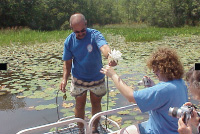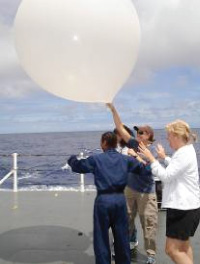 |
 |
 |
 |
 | Dr. John Dindo identifying invasive species and testing water quality.
Photo: Dauphin Island Sea Lab. |
COSEE Central Gulf of Mexico (CGOM) is a legacy collaborative that originated among colleagues and friends within academia and informal centers. This regional effort involved four of the five Gulf of Mexico (GoM) states with the following partners: The University of Southern Mississippi-Gulf Coast Research Laboratory-Marine Education Center and the Department of Marine Science at Stennis Space Center; the Institute for Marine Mammal Studies-Center for Marine Education and Research, Mississippi State University, and its Center for Education and Training Technology; and the Mississippi-Alabama Sea Grant Consortium in Mississippi; the University of Florida Natural Museum of History and Florida Sea Grant College Program; the Dauphin Island Sea Lab and Estuarium in Alabama; the Louisiana Universities Marine Consortium (2002-2007); and Loyola University and the Audubon Aquarium of the Americas in Louisiana. During 2002-2006 the University of Texas-Marine Science Institute represented Texas.
As a region, the GoM is a national treasure that often goes unnoticed for the contributions it provides, both within the United States and globally. Based on 2008 data, the five U.S. states that border the GoM had a gross domestic product of over 2.2 trillion dollars; if it was a country, the Gulf region would be the seventh largest economy in the world. Four key economic activities in the Gulf region are: 1) tourism and recreation, providing over 620,000 jobs; 2) crude oil production, producing over 27% of the domestic total from this region; 3) seafood, with major commercial fishing ports handling over 1.2 million pounds of fresh seafood annually; and 4) shipping, with six of the top 10 shipping ports in the U.S. located within the GoM. The GoM is the ninth largest water body in the world and teems with sea life, from commercially important seafood to deep water corals. This coastal region contains half the wetlands within the U.S. and serves as a home to sea turtles, marine mammals, nesting waterfowl, colonial water bird rookeries, and an incredible diversity of fishes.
The Gulf Coast region has experienced a significant population increase since 1970, growing by 103%. Hurricanes Katina and Rita adversely affected this growing population by displacing thousands of people, both temporarily and permanently in 2005. Not quite five years after Hurricane Katrina, the worst natural catastrophic event in recorded U.S. history, the citizenry within the GoM were faced with yet another devastating, man-induced coastal hazard, the British Petroleum Deepwater Horizon Oil Spill. Data are still being compiled on the negative effects on tourism, commercial and recreational fisheries, including seafood processors; marine habitats (wetlands, submerged meadows, marshes) and terrestrial habitats (beaches); and stranded (dead or alive) marine mammals, sea turtles, and migratory and shore birds
 | | A U.S. Navy meteorologist and two educators releasing an air balloon from the fantail of the 229-ft. USNS Pathfinder off the coast of Hawaii. Photo: COSEE CGOM Sea Scholars Program. |
The GoM contains the watershed of 31 U.S. states and two Canadian Provinces. It is critical for people within this watershed to be aware of and understand the importance of water quality and nutrient reduction, particularly with regard to agricultural and industrial management practices. It is also important that residents and visitors are knowledgeable about coastal and watershed habitats; are prepared for coastal hazards; and understand how the economy, the environment, and the GoM as an ecosystem are interconnected. To this end, COSEE CGOM has served as a catalytic, exemplary regional example in the following areas:
- Engaging scientists and formal and informal educators. The educator gained increased content knowledge based on the interpretations and relevance of current scientific research, and the scientist received a strengthened understanding of instructional skills, state and national standards, and how children learn.
- Using COSEE CGOM as a mechanism for achieving scientists’ needs for proof of broader societal impacts in increasing environmental (ocean and climate) literacy of the public visiting the four informal science centers where the Co-PIs are employed. (The Co-PIs also assisted the scientists in the development or refurbishing of exhibitry conveying research results and/or helping in the development of thematic brochures for the public.)
- Accomplishing the development and/or revision of 79 lesson plans by middle school teachers and aligning them with the Ocean Literacy Essential Principles and Fundamental Concepts and linking them to the GoM State Standards.
- Administering, analyzing, and interpreting short-term and select longitudinal evaluation and assessment data of the two, annual three-week Summer Institutes (face-to-face for one week and an online, distance-learning component encompassing a two-week timeframe with six scientists serving as keynote presenters), involving 12 pre- and inservice educators and five to seven scientists. Similar data were also collected, analyzed, and interpreted for the two, annual Two-Day Workshops involving two to three scientists and up to 40 formal and informal educators per Workshop.
- Providing an opportunity for 14 educators to go to sea aboard one of the U.S. Navy’s 329-ft. Oceanographic Survey Ships for seven to 10 days through its Sea Scholars Program. Educators worked side by side with Navy personnel, serving as active participants in making oceanographic surveys involving chemical, geological, physical, and biological sampling and advanced technologies through the use of side-scan sonar for bathymetric needs and in mapping the seafloor, as well as conducting acoustical, meteorological studies, and Naval applications of the data.
- Attempting to increase ethnicity through recruitment efforts with the GoM State Departments of Education, the National Marine Educators Association, GoM State Science Teachers Associations, the Marine Technology Society, the Gulf of Mexico Alliance, and the Gulf of Mexico Coastal Ocean Observing Systems, with the hopes that our educator and scientist participants would influence the career paths of their pre-college and/or undergraduate and graduate students within the STEM disciplines, particularly the ocean sciences.
- Due to the Deepwater Horizon Oil Spill, NSF Program Managers directed the COSEE CGOM Co-PIs to focus their fifth and final year of COSEE CGOM funding (2011) on oil-related findings by GoM scientists, with the goal of enhancing public understanding of this catastrophic event. Revised Statements of Work and Budgets were submitted in August 2010 and approved by NSF in January 2011 to implement face-to-face and video conference Community Forums in three locations within each of the four GoM states for up to 150 members of the general public per state.
Significant Accomplishments
Referred Journal Articles
- Kastler, Jessica, 2009. “Recipes for Hypoxia, Playing the Dead Zone Game.” Science Activities Magazine, Volume 46, No. 2, pp. 36-47.
- Sempier, Tracie. 2008. “Teacher Perceptions of the COSEE:Central Gulf of Mexico Programs.” A Ph.D. dissertation from MS State University, Starkville, MS. 366 pages.
- Spector, Barbara, Karen Blyler, & Michael Spranger. 2007. “Ocean Sciences and STEM Education: Rethinking Science Teaching,” Current, The Journal of Marine Education, Vol. 23, No. 2., p. 18.
- Walker, Sharon H. and Susan Cook. 2007. “Collaborations Between Formal and Informal Education,” Current, The Journal of Marine Education, Volume 23, Number 2, pp. 4-6.
- Walker, Sharon H. and Paula Keener-Chavis. 2006. “The Path to Ocean Sciences Literacy: Essential Steps Along the Way,” MTS Journal, Vol. 39, No. 4, pp. 20-32.
- Walker, Sharon H. , Craig Strang, & Susan Cook. 2006. “The COSEE: A National Success Story,” MTS Journal, Vol. 39, No. 4, pp. 33-40.
 | | Educators working with fauna diversity within the sediment at low tide. Photo: Dr. Mike Spranger, COSEE CGOM. |
Impacts of Scientist and Educator Engagement Through Summer Institutes, Two-Day Workshops, and/or the Sea Scholars Program
Over the last nine years, COSEE CGOM Co-PIs, educators, evaluators, and its 12-member Advisory Board involved 1,428 formal and informal educators and 198 different research scientists and/or U.S. Navy surveyors—42 of whom each participated in COSEE CGOM Professional Development Programs two or three times in meaningful, inquiry-based learning experiences. The 2003-2010 online presentations may be reviewed or downloaded from http://www.cosee.net/central-gom/. The 79 lesson plans may also be found on the website.
Additional COSEE CGOM Collaborators and Grants
- In 2002-2005, the Office of Naval Research and the National Oceanographic Partnership Program provided fiscal support to add the states of Texas and Florida, which enabled this effort to be expanded to all five states. The NOAA-National Sea Grant Program provided fiscal support for select staff salaries in the first COSEE CGOM award.
- The Naval Meteorology and Oceanography Command and the Naval Oceanographic Office provided a survey ship for implementation of the Sea Scholars Voyages from 2002-2011, depending on the national defense needs of this country.
- In 2005 the COSEE CGOM PI received funding from the NOAA-Ocean Exploration (OE)/National Marine Sanctuary Foundation for the implementation of four Deepwater Expedition Teacher Workshops in February, May, July, and September 2006.
- Pennsylvania State University requested scientist engagement and professional development for educators in 2009. A FLEXE: GLOBE Workshop, From Local to Extreme Environments, was implemented in July 2009, funded by the NSF’s GLOBE Project, the Mineral Management Service, and NOAA.
- In 2009, the NSF approved funding for a COSEE CGOM—American Recovery and Reinvestment Act (ARRA) proposal, Enhanced Engagement by Scientists for Broader Societal Impacts, on behalf the National COSEE Network. This successful award is producing case studies, one from each Center, that are placed on the Network website as they are produced and approved. These case studies describe and document how exemplary scientists use COSEE to develop model E/O programs for broader societal impacts.
- In 2010 NSF awarded the grant Responsive Oil Spill Outreach Based in Science to two Co-PIs, which complements the fifth year revised COSEE CGOM effort focusing on the Deepwater Horizon Oil Spill. This grant includes production of three television broadcasts of roundtable oil-spill discussions among scientists, and a moderated website that provides interviews with scientists, questions and answers, blogs, and annotated resources regarding the spill.
Local, Regional, National, and International Presentations
The Co-PIs made 164 presentations from 2003-2010. Of this number 82 presentations were local; 17 presentations were regional; 54 presentations were national; and 11 presentations were international.
Public Positively Impacted by COSEE CGOM Efforts
Over the nine-year duration of this effort, 5.4 million guests visiting the informal science centers in which the Co-PIs are employed have been and are being influenced by the collaborative efforts of participating scientists and formal and informal educators.
Visit COSEE CGOM!
|
 |
 |
 |
 |
|
 |

